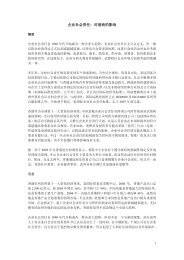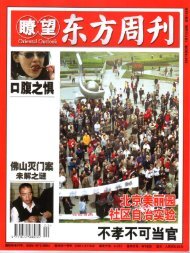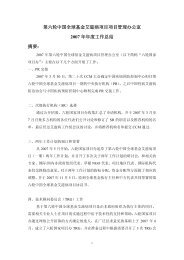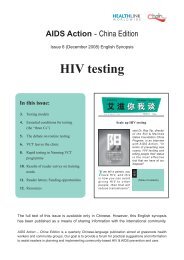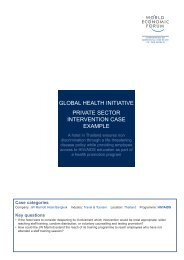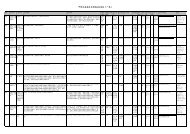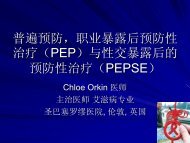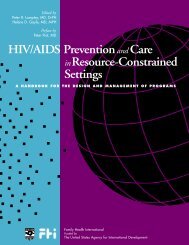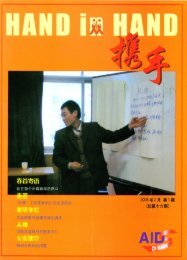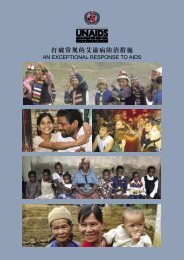The Training of Trainers Manual - UNFPA
The Training of Trainers Manual - UNFPA
The Training of Trainers Manual - UNFPA
Create successful ePaper yourself
Turn your PDF publications into a flip-book with our unique Google optimized e-Paper software.
<strong>The</strong> health belief model<br />
<strong>The</strong> health belief model suggests that if a person has a desire to avoid illness or to get well (value) and<br />
the belief that a specific health action will prevent illness (expectancy), then the person will take a<br />
positive action towards that behaviour. An important aspect <strong>of</strong> the health belief model is the concept <strong>of</strong><br />
perceived barriers, or one’s opinion <strong>of</strong> the tangible and psychological costs <strong>of</strong> the advised action.<br />
Peer educators could reduce perceived barriers through reassurance, correction <strong>of</strong> misinformation, and<br />
assistance. For example, if a young person does not seek health care in the local clinic because he or<br />
she feels that confidentiality is not respected, the peer educator may provide accurate information on a<br />
youth-friendly service, thus helping to overcome the barrier to accessing proper health care.<br />
Social ecological model for health promotion<br />
According to this model, behaviour is determined by the following:<br />
■ Intrapersonal factors – characteristics <strong>of</strong> the individual such as knowledge, attitudes, behaviour, selfconcept,<br />
and skills<br />
■ Interpersonal processes and primary groups – formal and informal social network and social support<br />
systems, including the family, work group, and friendships<br />
■ Institutional factors – social institutions with organizational characteristics and formal and informal<br />
rules and regulations for operation<br />
■ Community factors – relationships among organizations, institutions, and informal networks within<br />
defined boundaries<br />
■ Public policy – local, state, and national laws and policies<br />
This theory acknowledges the importance <strong>of</strong> the interplay between the individual and the<br />
environment, and considers multilevel influences on unhealthy behaviour. In this manner, the<br />
importance <strong>of</strong> the individual is de-emphasized in the process <strong>of</strong> behavioral change.<br />
IMBR model: information, motivation, behavioural skills, and resources<br />
<strong>The</strong> IMBR model addresses health-related behaviour in a way that can be applied to and across different<br />
cultures. It focuses largely on the information (the ‘what’), the motivation (the ‘why’), the behavioural<br />
skills (the ‘how’), and the resources (the ‘where’) that can be used to target at-risk behaviours. For<br />
example, if a young man knows that using condoms properly may prevent the spread <strong>of</strong> HIV, he may be<br />
motivated to use them and know how to employ them correctly, but he may not be able to purchase or<br />
find them. Thus, the concept <strong>of</strong> resources is important to this model.<br />
In the context <strong>of</strong> peer education, this means that a programme that does not include all four IMBR<br />
concepts probably lacks essential components for reducing risk behaviour and promoting healthier<br />
lifestyles. A programme might, for example, explain to young people the need for contraception and<br />
describe contraceptive methods but omit demonstrating their proper use. Participants would then be<br />
informed about what to do but not how to do it.<br />
136 <strong>Training</strong> <strong>of</strong> <strong>Trainers</strong> <strong>Manual</strong>




